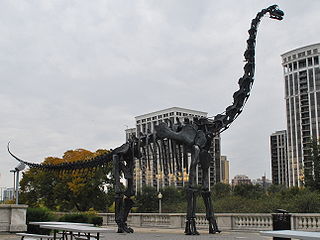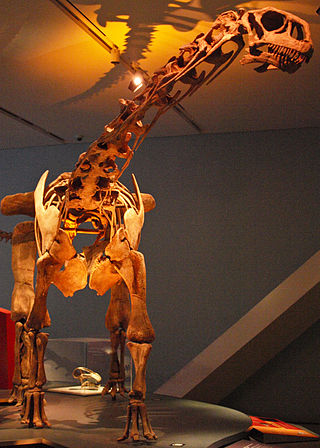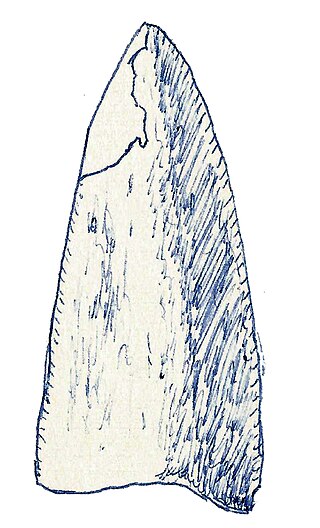
Quaesitosaurus is a genus of nemegtosaurid sauropod containing only the type species, Q. orientalis, described in 1983. It lived from 72 to 71 million years ago during the Late Cretaceous epoch in the Barun Goyot Formation. With long, low and horse-like with frontally located peg-teeth, the skull of Quaesitosaurus is similar enough to the skull of Diplodocus and its kin to have prompted informed speculation that the missing body was built like those of diplodocids.

The Brachiosauridae are a family or clade of herbivorous, quadrupedal sauropod dinosaurs. Brachiosaurids had long necks that enabled them to access the leaves of tall trees that other sauropods would have been unable to reach. In addition, they possessed thick spoon-shaped teeth which helped them to consume tough plants more efficiently than other sauropods. They have also been characterized by a few unique traits or synapomorphies; dorsal vertebrae with 'rod-like' transverse processes and an ischium with an abbreviated pubic peduncle.

Antarctosaurus is a genus of titanosaurian sauropod dinosaur from the Late Cretaceous Period of what is now South America. The type species, Antarctosaurus wichmannianus, and a second species, Antarctosaurus giganteus, were described by prolific German paleontologist Friedrich von Huene in 1929. Three additional species of Antarctosaurus have been named since then but later studies have considered them dubious or unlikely to pertain to the genus.

Bonitasaura is a genus of titanosaurian dinosaur hailing from uppermost layers of the Late Cretaceous (Santonian) Bajo de la Carpa Formation, Neuquén Group of the eastern Neuquén Basin, located in Río Negro Province, Northwestern Patagonia, Argentina. The remains, consisting of a partial sub-adult skeleton jumbled in a small area of fluvial sandstone, including a lower jaw with teeth, a partial vertebrae series, and limb bones, were described by Sebastian Apesteguía in 2004.

Malawisaurus is an extinct genus of titanosaurian sauropod dinosaur. It is known from the Dinosaur Beds of northern Malawi, which probably date to the Aptian stage of the Early Cretaceous. The type species is M. dixeyi and the specific name honours Frederick Augustus Dixey.

Rebbachisauridae is a family of sauropod dinosaurs known from fragmentary fossil remains from the Cretaceous of South America, Africa, North America, Europe and possibly Central Asia.

Asiatosaurus is an extinct genus of herbivorous sauropod dinosaur which lived during the Early Cretaceous in Mongolia and China. The type species is known only from teeth, making it difficult to rely on information until more specimens are found to expand our knowledge, and another species is known, also based on scant remains; both are now classified as nomina dubia.
Chiayusaurus is a genus of sauropod dinosaur known from teeth found in China and possibly also South Korea. Two species have been named for this obscure genus, though only the type, C. lacustris, is still seen as valid. It was originally named as Chiayüsaurus, but the ICZN does not permit special characters, so the name was corrected to Chiayusaurus. The obsolete name can still be seen in older sources, though. As a sauropod, Chiayusaurus would have been a large, quadrupedal herbivore.
Chinshakiangosaurus is a genus of dinosaur and probably one of the most basal sauropods known. The only species, Chinshakiangosaurus chunghoensis, is known from a fragmentary skeleton found in Lower Jurassic rocks in China. Chinshakiangosaurus is one of the few basal sauropods with preserved skull bones and therefore important for the understanding of the early evolution of this group. It shows that early sauropods may have possessed fleshy cheeks.

Astrodon is a genus of large herbivorous sauropod dinosaur, measuring 20 m (66 ft) in length, 9 m (30 ft) in height and 20 metric tons in body mass. It lived in what is now the eastern United States during the Early Cretaceous period, and fossils have been found in the Arundel Formation, which has been dated through palynomorphs to the Albian about 112 to 110 million years ago.

Mongolosaurus is a genus of titanosauriform sauropod dinosaur which lived during the Early Cretaceous of China.

Phuwiangosaurus is a genus of titanosaur dinosaur from the Early Cretaceous (Valanginian-Hauterivian) Sao Khua Formation of Thailand. The type species, P. sirindhornae, was described by Martin, Buffetaut, and Suteethorn in a 1993 press release and was formally named in 1994. The species was named to honor Princess Maha Chakri Sirindhorn of Thailand, who was interested in the geology and palaeontology of Thailand, while the genus was named after the Phu Wiang area, where the fossil was discovered. The precise affinities of Phuwiangosaurus among titanosauriform sauropods are uncertain, though several studies have classified it as a euhelopodid.

Rinconsaurus is a genus of titanosaur sauropod dinosaur from the Late Cretaceous in what is now Argentina. The type species, Rinconsaurus caudamirus, was described by Calvo and Riga in 2003, and is based on three partial skeletons.

Moabosaurus is a genus of turiasaurian sauropod dinosaur from the Early Cretaceous Cedar Mountain Formation of Utah, United States.
Malawisuchus is an extinct genus of notosuchian mesoeucrocodylian from the Early Cretaceous Dinosaur Beds of Malawi. It was described in 1997 by Elizabeth Gomani as a member of the family Notosuchidae. The type species is M. mwakasyungutiensis, referring to Mwakasyunguti, the area of northern Malawi where it was found. It was classified as a member of the family Itasuchidae by Carvalho and colleagues in 2004.
The El Collado Formation is a geological formation in Cuenca, Spain whose strata date back to the Early Cretaceous. Dinosaur remains are among the fossils that have been recovered from the formation.
The Dinosaur Beds is a geological formation in Malawi whose strata date back to the Early Cretaceous. The age of the deposit is poorly constrained, but is likely to date from the Barremian to Aptian. Dinosaurs, turtles and crocodylomorphs remains are among the fossils that have been recovered from the formation. It is correlated with the Galula Formation in Tanzania. It consists of two members, a lower unfossiliferous member consisting of deep red stained sandstones, and an upper fossiliferous member consisting of white sands and grey to red mudstones and siltstones. The upper member is 210 m thick in the vicinity of the CD-9 locality.

Abydosaurus is a genus of brachiosaurid sauropod dinosaur known from skull and postcranial material found in upper Lower Cretaceous rocks of northeastern Utah, United States.
Brasilotitan is a genus of titanosaurian sauropod dinosaur from the Late Cretaceous Adamantina Formation of Brazil. The type species is Brasilotitan nemophagus. Brasilotitan was a small titanosaur with a squared-off snout, and may be closely related to another Brazilian titanosaur, Uberabatitan.

Yongjinglong is an extinct genus of titanosauriform sauropod dinosaur known from the Early Cretaceous of Lanzhou-Minhe Basin of Gansu Province, China. It contains a single species, Yongjinglong datangi.


























